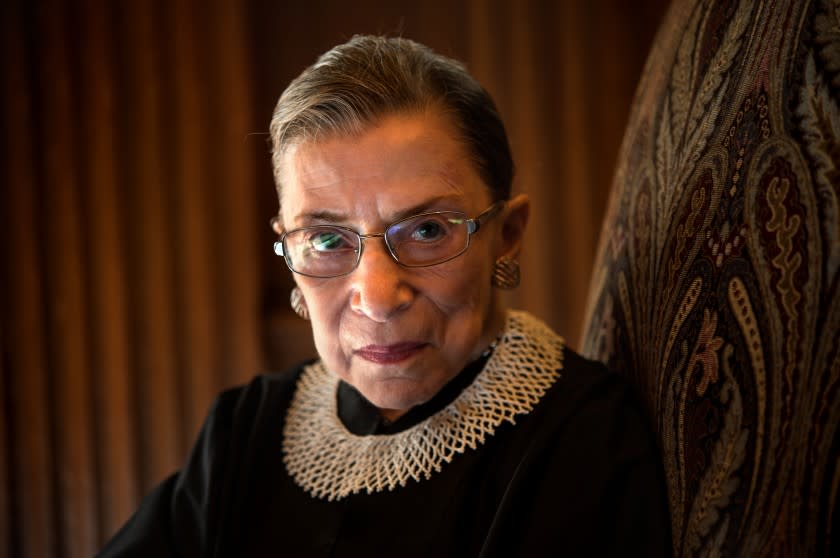Editorial: Ruth Bader Ginsburg, a Supreme Court icon, is dead. The Senate should wait to replace her.

The death of Ruth Bader Ginsburg deprives the Supreme Court and the nation of a towering figure in the campaign to ensure equal justice under law. Her passing also creates an opportunity for President Trump, who already has appointed two justices, to name a replacement in the waning months of his term.
For the good of the country and the court, the Republican-controlled Senate should treat any Trump nominee, however well qualified, the same way the Senate treated President Obama's nominee to replace Justice Antonin Scalia in 2016. They should not act on any nomination until after the president elected in November is inaugurated, whether it be Trump or former Vice President Joe Biden.
Even before she became a judge, Ginsburg had spearheaded a push to transform how the law viewed discrimination on the basis of sex. She continued that witness after joining the court in 1993, writing the majority opinion in 1996 when the court ruled that the 14th Amendment’s guarantee of equal protection of the law meant that the Virginia Military Institute could not exclude women. Her role as a trailblazer and exemplar for women and a defender of women's rights cannot be overstated.
As the court moved right, she remained a champion of a vision of the law and the Constitution that promoted democracy rather than constricting it. When the conservative majority gutted an important provision of the Voting Rights Act in 2013, Ginsburg wrote a powerful dissent that mocked the majority’s quixotic confidence that federal protections for minorities at the ballot box were no longer necessary. Throwing out federal scrutiny of potentially discriminatory election practices because it had worked, she said, was like “throwing away your umbrella in a rainstorm because you are not getting wet.”
Like Scalia, her longtime friend and colleague, Ginsburg died during a presidential election year marked by divisiveness, cultural conflict and partisan acrimony. When Senate Majority Leader Mitch McConnell refused to allow the Senate to consider any Obama nominee, this editorial page criticized him for his argument that the seat must be left unfulfilled so that the voters could have a say in the selection of the next justice. We called it "self-serving sophistry."
McConnell’s rationale for blocking consideration of Judge Merrick Garland, Obama’s exquisitely well-qualified choice to replace Scalia, should lead him to delay any action on a Trump nominee. Not surprisingly, McConnell isn't displaying such consistency. On Friday night, he said that “President Trump’s nominee will receive a vote on the floor of the United States Senate,” although he didn't specify whether a vote would be taken before the election or in a lame-duck session. (McConnell disingenuously suggested, as he has before, that 2020 is different from 2016 because the Senate and the White House are controlled by the same party.)
Under the Constitution, Trump has the right to nominate a replacement for Ginsburg, just as Obama had the right to try to replace Scalia. A president’s constitutional authority does not decline as the end of a term approaches, like a light with a dimmer switch. But there are several reasons for the Senate not to act.
Scalia died in February of 2016, and Obama nominated Garland on March 16, giving the Senate ample time to consider his nomination for a lifetime seat on the nation's highest court and conduct an appropriate public vetting. It is now September, and senators are in campaign mode. With the pre-election recess fast approaching, senators can't reasonably argue that there is enough time for a thorough confirmation process.
But even if there were time, other considerations argue for delay. The country is more sharply divided than in 2016, thanks in large part to the demagoguery of the incumbent president, who has fanned the flames of bigotry at a time of a reckoning over America’s legacy of racism.
The Supreme Court, meanwhile, faces a crisis of confidence. Despite the admirable efforts of Chief Justice John G. Roberts Jr. to build consensus, the court is widely viewed as a partisan institution. That is partly the result of the way Democratic appointees often vote one way and Republican appointees another, but it also reflects the poisonous partisanship that has infected the Supreme Court confirmation process. Few nominees of either party can expect to be approved by overwhelming bipartisan majorities, as Scalia and Ginsburg were.
Senate action on a Trump nominee so close to the election — and in the shadow of the Senate’s refusal in 2016 to act on Obama’s nominee — would exacerbate partisan divisions and plunge the court even further into partisan politics. So, too, would confirming a justice in a lame duck session if Trump does not win reelection.
There is another way: Republican Sens. Lisa Murkowski of Alaska and Susan Collins of Maine suggested before the announcement of Ginsburg's death that it might be too close to the election for a confirmation vote on a Supreme Court nominee. If even a few more Republican senators prudently recognize the need for delay, the country and the court will be better off.

